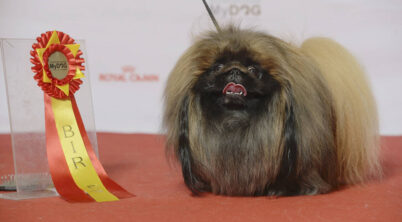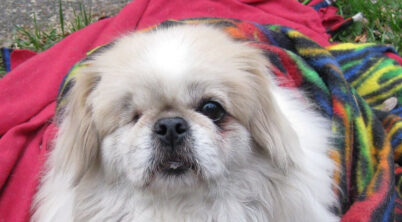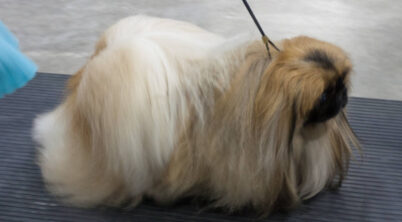Pekingese dogs, with their lion-like appearance and regal origins, are a unique and charismatic small breed once revered by Chinese royalty. Known for their unwavering loyalty and surprisingly courageous attitudes, Pekingese possess an independent spirit that often belies their diminutive stature. Despite their charming characteristics, Pekingese owners may sometimes notice their furry companions exhibiting unusual shaking behavior, which can be concerning. The causes of this shaking are varied and can range from simple explanations to more serious health concerns.
In considering the health of a Pekingese that keeps shaking, it is important to observe the context and other symptoms that may accompany this behavior. Shaking or trembling could suggest a number of issues, some of which include experiencing seizures, where a loss of body control is evident, or reacting to stress and fear, common in dogs with a strong personality such as the Pekingese. Furthermore, underlying health problems like skin issues, which may manifest through symptoms such as excessive scratching and hair loss, could also contribute to distress and consequent shaking.
An owner’s observation is crucial in determining why their Pekingese might be shaking. It is essential for owners to monitor for additional signs that may indicate the presence of health issues, such as changes in behavior, reactivity on a leash, or physical symptoms like scabbing or redness of the skin. Understanding these signs and seeking veterinary advice when necessary can help ensure that the Pekingese remains healthy, happy, and as dignified as their noble lineage suggests.
Pekingese Keeps Shaking
When a Pekingese dog exhibits shaking behavior, it is essential to understand the potential causes and appropriate actions to take. Identifying the reasons behind the shaking can inform whether there is a need for immediate veterinary attention.
Why Pekingese Might Keep Shaking
- Health-related Causes:
- Seizures: The shaking could be indicative of seizures, which may cause involuntary muscle movements and loss of control.
- Pain or Discomfort: Pain from an injury or an underlying health condition can lead to shaking as a response.
- Fear or Anxiety: Stressful situations might provoke a Pekingese to shake as part of a fear response.
- Cold or Chills: Like humans, dogs might shake when feeling cold.
- Environmental and Behavioral Causes:
- Excitement or Anticipation: Dogs may shake due to excitement or when they anticipate something they enjoy.
- Seeking Attention: Some Pekingese might shake as a way of communicating a need for attention or care.
What to Do if Pekingese Keeps Shaking
- Immediate Actions:
- Observation: Carefully observe the shaking to assess any additional symptoms or triggers.
- Comforting: Provide a calm and comforting environment for the dog, away from stressors.
- Medical Assistance:
- Consult a Veterinarian: If the shaking persists or is accompanied by other symptoms (vomiting, crying out, etc.), seek professional advice promptly.
- Follow Treatment Plans: If a health issue is diagnosed, adhere strictly to the veterinarian’s treatment plan.
- Preventive Measures:
- Routine Check-ups: Ensure regular veterinary visits to keep the Pekingese’s health in check.
- Maintain Warmth: Keep the dog warm and sheltered to prevent shaking from cold.
By understanding these factors and taking a deliberate approach to care, a Pekingese’s well-being can be effectively managed.
Understanding Pekingese Health
The well-being of a Pekingese relies on awareness of health issues and earliness in detecting symptoms. Ensuring they are happy and healthy involves regular veterinarian check-ups and knowledge of their common ailments.
Common Health Problems
Pekingese dogs, known for their regal appearance, often suffer from health problems related to their distinctive physical features. Some of these issues include:
- Brachycephalic Syndrome: Breathing difficulties due to their short muzzles.
- Obesity: A tendency to gain weight which can exacerbate other health issues.
- Dental Problems: Their small mouths can lead to crowded teeth and dental disease.
- Skin Problems: Folds in the skin can harbor bacteria or yeast, leading to infections.
- Allergies: Prone to various allergies, which may manifest as skin irritations.
Symptoms and Early Detection
Early detection of health issues can be crucial for a Pekingese’s overall health. Symptoms warranting attention include:
- Coughing: Can be a sign of heart or lung problems.
- Lethargy: A noticeable decrease in energy might indicate underlying illness.
- Vomiting: Persistent vomiting could signify gastrointestinal issues or toxicity.
Observing and responding to these symptoms quickly enhances the quality of life for a Pekingese.
Professional Care and Treatments
Upon detection of any health problems, a Pekingese should be examined by a veterinarian who may prescribe:
- Medications: To manage symptoms of disease or to treat infections.
- Surgery: May be necessary for severe breathing difficulties or to resolve injuries.
- Ongoing Treatment: For chronic conditions, such as allergies or dental care.
Professional veterinary care is critical for maintaining a healthy and comfortable life for a Pekingese.
The Impact of Aging
As Pekingese approach old age, their susceptibility to health problems increases:
- Vision Loss: Aging can lead to blindness or other ocular issues.
- Dental Disease: Advanced dental problems can become more common.
- Chronic Disease Management: Older dogs may need regular treatment for chronic conditions.
Awareness of the aging process and its impact on their health allows for the appropriate care to manage any conditions that arise.
Grooming and Skin Care
Proper grooming is paramount for a Pekingese’s skin health and overall well-being. A Pekingese’s heavy coat requires consistent brushing to remove loose hair and prevent matting. Brushing also distributes natural oils, which is beneficial for the health and appearance of their coat.
Skin Problems and Grooming Regimen
- Regular grooming can help identify early signs of skin problems such as dermatitis, allergies, and hot spots.
- Itching and discomfort may be alleviated through gentle grooming practices that avoid aggravating sensitive skin.
Choosing the Right Grooming Products
- Shampoo: Use a high-quality dog shampoo that caters to the Pekingese’s skin pH level to avoid irritation.
- Brushes: Select brushes that detangle without pulling, reducing the likelihood of skin irritation and increasing comfort.
Dirt and Parasites
- Regular grooming removes accumulated dirt and helps in checking for parasites, which, if left unchecked, can lead to severe skin issues.
Gentleness and Quality of Life
- Gentle grooming contributes to their quality of life, providing a happy, stress-free experience.
- Addressing skin conditions with proper care ensures the comfort of the Pekingese, allowing them to lead a contented life.
Maintaining a consistent grooming routine aids not just in keeping the Pekingese neat but also in monitoring their skin condition, ensuring they remain happy, healthy, and comfortable.
Nutrition and Exercise
Proper nutrition and regular exercise are fundamental in maintaining a Pekingese’s overall health and happiness. These components play a crucial role in preventing obesity and related health problems, which are common in this small breed.
Feeding for Optimal Health
For a Pekingese to thrive, proper nutrition is key. They require a high-quality diet tailored to their small size and specific energy needs. Adult Pekingese typically need about 1/2 to 1 cup of dry food per day, divided into two meals to sustain their lifestyle. However, due to their propensity for obesity, it is essential to measure their food and avoid overfeeding. Treats should be given sparingly and must account for their daily calorie intake.
The Role of Physical Activity
Regular exercise is equally important to maintain a Pekingese’s weight and improve their quality of life. Despite their small size, Pekingese can enjoy a moderate amount of daily activity. However, their flat faces can cause breathing difficulties, so exercise should be mild and not too strenuous. Short walks in the cooler parts of the day or play sessions indoors are suitable to keep them active without risking overheating.
Understanding Breed Limitations
Pekingese’s small size and distinctive physiology impose certain limitations on their exercise regimen. They are prone to heart disease and can quickly overheat due to their flat faces. Owners should be vigilant for signs of exhaustion or distress during activity. Moreover, the Pekingese’s living environment should accommodate their exercise needs while being mindful of their susceptibility to breathing difficulties and overheating.
Behavioral and Environmental Considerations
When assessing why a Pekingese may exhibit shaking behavior, environmental factors and behavioral conditions play crucial roles. Anxiety or fear may be present in Pekingese that tremble or shake. They might react to unfamiliar situations or loud noises, reflecting their need for a calm and stable environment to promote well-being.
Rest and a routine are pivotal in preventing stress-induced behaviors. Pekingese dogs thrive on consistency and can become anxious if their environment is unpredictable. Sufficient rest in a comfortable space can help them stay calm and happy.
Advocates for the breed emphasize the importance of patience in addressing any unwanted behavior, including shaking. Training methods can be employed to counteract reactions caused by excitement or anxiety. Positive reinforcement and rewards can encourage a Pekingese to remain composed.
| Behavioral Factors | Environmental Factors |
|---|---|
| Fear | Noise levels |
| Anxiety | Routine and consistency |
| Excitement | Comfortable resting area |
| Loyalty (to owners) | Stable living conditions |
Brain and muscle stimulation through exercise and play can offset nervousness. Maintaining an active lifestyle for a Pekingese helps channel their energy constructively, fostering a sense of loyalty and keeping them content.
Professional guidance or veterinary advice should be sought if shaking persists, as these symptoms may arise from underlying health issues beyond behavioral and environmental scopes.
Recognizing and Responding to Emergencies
When a Pekingese begins to shake uncontrollably, it can be a sign of a serious health emergency that requires immediate attention, as it may indicate pain, discomfort, or a medical condition. Owners need to recognize the signs that warrant first aid or professional veterinary help.
First Aid and When to Seek Help
In the event that a Pekingese shows signs of distress such as shaking, vomiting, or difficulty breathing, the owner should react calmly but swiftly. Providing comfort and stability is crucial; one should gently hold the dog to prevent injury and closely monitor its condition. If these symptoms persist for more than a few minutes or are accompanied by lethargy or gagging, the owner must contact a veterinarian immediately. It is vital to know the signs that differentiate normal behavior from health-related emergencies that warrant professional medical intervention.
- Contact a Veterinarian:
- Persistent shaking or tremors
- Continuous vomiting or gagging
- Breathing difficulties
- Sudden lethargy or unresponsiveness
Signs of Serious Health Issues
Certain symptoms in a Pekingese are indicative of serious health problems or underlying disease. A Pekingese shaking could be experiencing a seizure, possibly related to neurological conditions or exposure to toxic substances. Infections, whether from bacteria or viruses, often present with systemic symptoms like fever, vomiting, and disorientation.
- Monitor for Symptoms:
- Seizure activity (shaking, tremors)
- Excessive panting or coughing
- Gastrointestinal distress
- Unusual levels of discomfort or pain
- Physical Signs:
- Check for signs of injury or trauma
- Inspect skin for signs of infections, parasites, or allergies (redness, hair loss)
Owners should remain vigilant for these signs and seek professional guidance as neglecting them may lead to exacerbating the Pekingese’s condition, potentially leading to long-term health issues or even life-threatening diseases.








